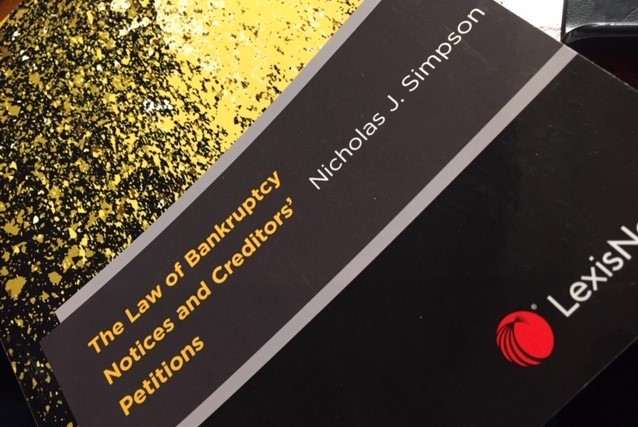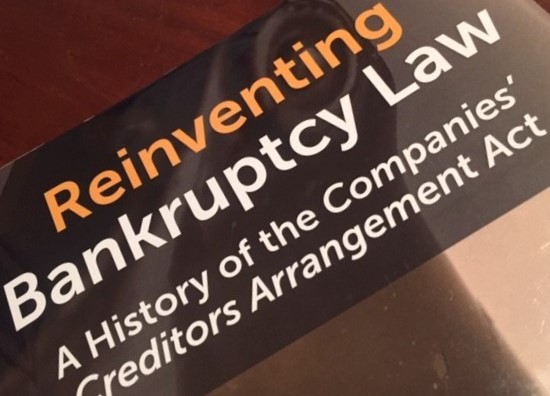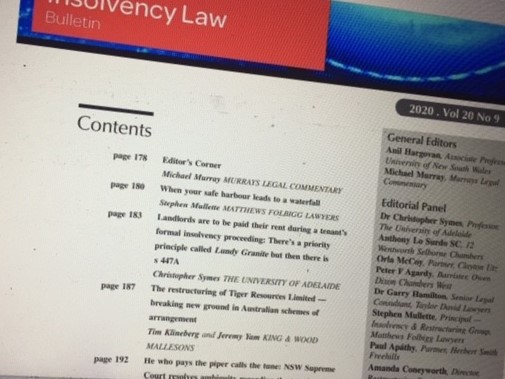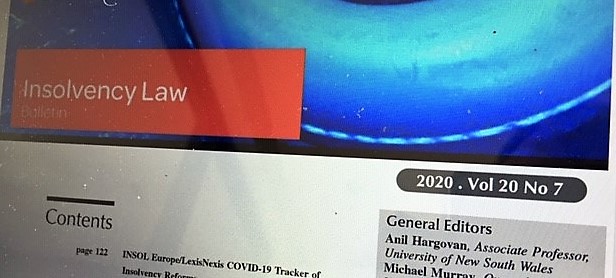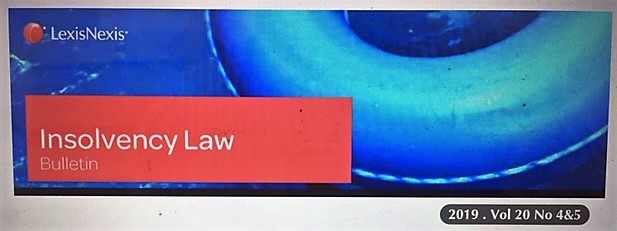Books and journals
How low can we go – funding the insolvencies of assetless estates
Obvious as it is to say, insolvency involves limited or no money, and how to fund its existence as a
The Law of Bankruptcy Notices and Creditors’ Petitions, by Nicholas J Simpson, 2020 – a book review
22/12/2020
book review Books and journals Articles
This is a very good and topical Australian text, adequately and accurately described by its title. My review of it
Reinventing Bankruptcy Law – Virginia Torrie
21/12/2020
book review Books and journals Articles US/Canada
This is a very good book on Canadian insolvency law, sadly with no equivalent in Australia, as I explain below.
ATO’s right to garnishee – a “privileged position … likely to result in failed corporate rescue attempts”?
27/10/2020
ATO MSME garnishee notices Books and journals
A recent article Getting the priorities right: ATO garnishee notices in times of corporate distress by Sylvia Villios and David
Insolvency Law Bulletin – safe harbour, Tiger Resources, Virgin and who’s the employer
10/09/2020
Insolvency Law Bulletin General Books and journals
The latest Insolvency Law Bulletin contains a warning about the (then) ending on 24 September of the COVID-19 protections, now
How is Australia’s safe harbour from insolvent trading working? some survey results
21/06/2020
588G safe harbour TMA Australia 588GA
An article by Professor Ian Ramsay and Associate Professor Stacey Steele has just been published reporting on survey responses of
Insolvency Law Bulletin – June 2020
11/06/2020
Insolvency Law Bulletin NZ Books and journals Articles
The latest issue of the Insolvency Law Bulletin has just appeared containing a wide range of topics in personal and
Feminist input to the theories of insolvency?
14/05/2020
articles feminism insolvency theory Books and journals
For those who would like to see how it is said that ‘feminist ideals’ are met in one or other
UNCITRAL guidance on MSE insolvency – Insolvency Law Bulletin article
18/04/2020
Insolvency Law Bulletin MSE General Books and journals
An article in the latest Insolvency Law Bulletin[1] reports on the progress of UNCITRAL Working Group V[2] in developing law
The proposed reinvigoration of the UK’s business rescue culture through ‘recalibration of the balance of power’ – some steps too far for Australia?
01/03/2020
debtor in possession regulation UK UK restructuring
A recent academic article from the UK has reviewed proposed restructuring reforms announced by the government in August 2018, although
A not so simple fix for franchise insolvency?
22/02/2020
franchises General Books and journals Articles
The financial collapse of a franchisor can have a severe impact on its franchisees but a “simple fix” proposed to
Three year ‘imprisonment’ for bankruptcy debt
Australia has historically been seen as severe in its approach to unpaid debt and opposition to changing the 3 year
Insolvency R&B law reform ideas
01/01/2020
ASIC fees government liquidator UK abandoned companies
While the ASBFE Ombudsman, ARITA and others are looking at insolvency law reform, including for SMEs, they will no doubt
Halifax – a cross-border insolvency
15/12/2019
NZ letter of request General Books and journals
A joint hearing of Australian and New Zealand courts is one way to deal with an intermingled cross-Tasman insolvency, through
Insolvency Law Bulletin – penalties, phoenix & preferences, franchises & offence reports
30/11/2019
ALRC Cross-border insolvency offence reporting penalties
The latest issue of the Insolvency Law Bulletin (2019) 20(4&5) covers some very topical issues. The Halifax Investment Services matter
The evolution of bankruptcy and insolvency laws and the case of the deed of company arrangement
05/10/2019
holding DOCA UK General Books and journals
This is a thoughtful and instructive article on the process of the historical development of the bankruptcy and insolvency laws
Digital disruption is here but “progress towards a digital insolvency practice has to date been slow”
A recent journal article on the impact of artificial intelligence and its use by the insolvency profession has good and
‘A good idea’ – assignment of a liquidator’s recovery rights
18/09/2019
UK assigment of claims Books and journals Articles
A liquidator has transferred, with court approval, potential recovery claims to the ATO, as the major and only creditor in
A bankrupt’s list of ‘personal’ assets
26/05/2019
Books and journals
The law requires those people in bankruptcy to record their assets and liabilities in a ‘statement of affairs’. It is
Keay’s Insolvency – note from the authors – progressive updates since publication
24/02/2019
General Books and journals Blog
As the authors of Keay’s, and in order to assist readers, we propose to make brief reference to law changes
Law reform obituary – CAMAC 1983-2018
28/10/2018
articles CAMAC General Books and journals
The Corporations and Markets Advisory Committee (CAMAC) was a corporate law reform body comprising individuals eminent in that field. It
Keay’s Insolvency – a law reform launch
27/08/2018
Keay's Insolvency General Books and journals Articles
The recent launch of the new 10th edition of Keay’s Insolvency prompted some pointed comments about the current insolvency system
Friendly and ‘friendly’
20/05/2017
articles ASIC commentary Fair Entitlements Guarantee - FEG
With the rather confusing term ‘friendly liquidator’ continuing to be used: by the media: Dirty Deeds: Inside Australia’s Biggest Tax
Categories
Main Menu


